| Publisher: | Themeborne Ltd. | Publish Year: | 2018 |
| Designers: | Alex Crispin, Thomas Pike, James Shelton | Player Scale: | 1 – 4 |
| Artist: | Alex Crispin | Run Time: | 20 Minutes |
You’ve spent years languishing inside that dank, dark pit; the dungeon of the Dark Castle, and now, now you have your means of escape. All you have to do, to once again breathe deep the free air is make it past un-named inhuman beasts, guards and ne’er-do-wells beyond number.
Oh, and the traps.
And the wicked temptation of booby-trapped treasure.
And of course, the evil overlord of the Dark Castle itself who awaits at the very end. But then, once you’ve bested that nightmare, then you’ll finally be free. Not bad for twenty minutes of gameplay.
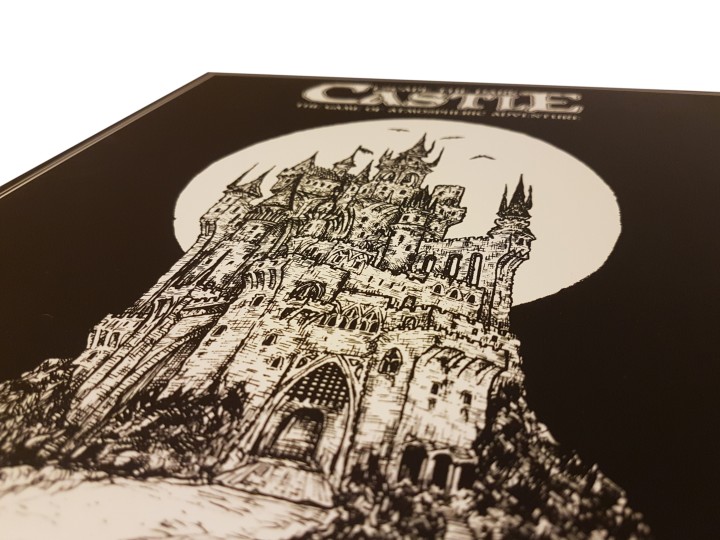
Escape The Dark Castle not only throws you and your fellow prisoners into jail, but it throws you back in time with the lovingly nostalgic choose your own adventure style gameplay. Everything about it screams atmospheric-retro adventure/horror fun. From the stark white-on-black box, the fonts used and of course the eye grabbingly bleak artwork. The Kickstarter video has to be one of my all-time favourite promotional videos capturing the essence of the game and the gameplay itself. In Escape from the Dark Castle one to four players will choose their characters, and upon collecting your character specific, custom die you’ll set forth. And it is from here, the very beginning of the game, you’ll notice something is very different, you are not choosing heroes. No, far from it, you are but simple folk, Tailors, Cooks, Abbots and the like, and much like the style of the game, your chances of survival are bleak.

The game is incredibly simple, reveal a Chapter Card from your individual story/adventure deck of fifteen cards – and you’ll do so just like turning a page in a book. The Page Turner reads aloud the text on the card – which is pretty much all flavour – no additives or preservatives in sight – and as a group make your choice, roll some dice, match some symbols and that’s it. Continue exploring your own adventure until you’re out, or someone dies. And death comes all too easily in the Dark Castle. You’ll very quickly come to realise the fragility of your characters and relish those literal rotten apples which provide meagre, but much needed health points.
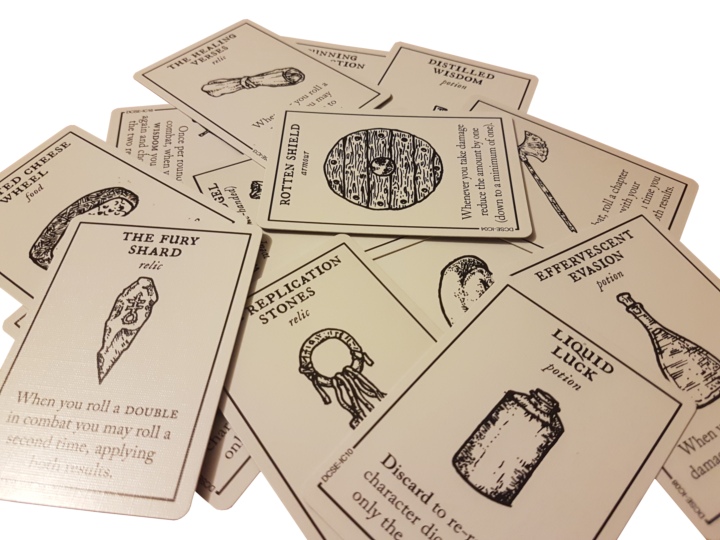
Most of the challenges you’ll face, including combat, are resolved using your character dice, with each character’s die being slightly different. Your character card will show how many of each symbol – Might, Cunning, and Wisdom – appears on your die (by the very atmospheric scratches on the wall), meaning every character has a couple of doubles.
The in-game conflict comes in the form of simply rolling matching symbols to those of the Chapter Card. On some of the meatier monsters, this will be three or four symbols plus a chapter die roll from each player, on some of the “easier” challenges you’ll be given a chance roll X number of Wisdom in Y amount of attempts. Fail to kill or complete the Chapter and you’ll lose (read: haemorrhage) health.
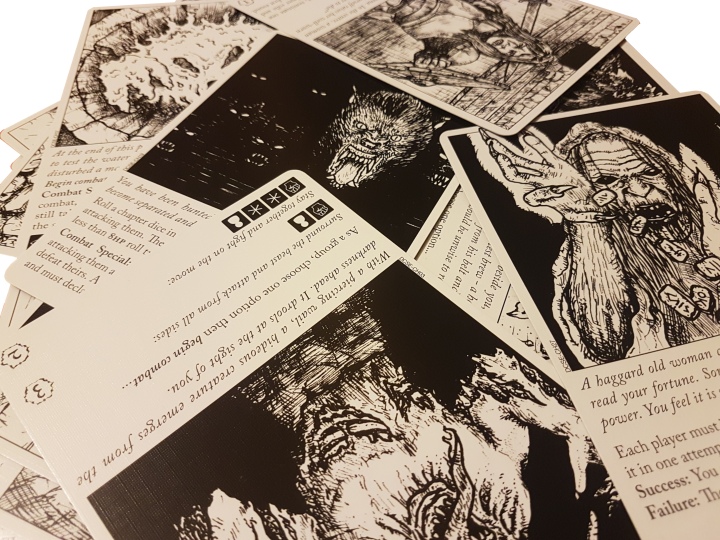
This does mean that the game hinges heavily on the luck of a roll – yet in doing so the game accomplishes its main objective: immersion. There are no cards to sort or shuffle (once you’ve completed set-up), no tokens or pawns to move around and once you remember what each of the symbols are called, you’ll probably never need the rulebook. This simple, easy elegance keeps all players in the game, and more importantly, invested in their story. When you play this game you’ll be “Telling a story”, just as much as you’re playing a game. With forty-five total chapter cards, and only fifteen used each game there are many ways to Escape the Dark Castle and many stories to be a part of.
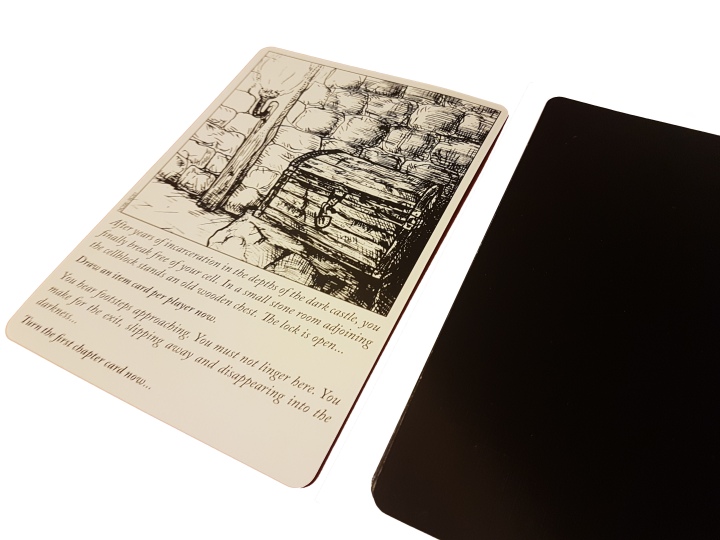
One cannot help but smile when a string of cards are drawn consecutively that make a cohesive sense, whether by design or chance that this deck of cards just happens to be telling a logical story. None of the Chapter cards in my experience are “good” they are varying shades of bad, and the pattern I’ve come to notice is, the more darkness in the picture, the more health you’ll almost certainly lose. One of my favourite parts of this game is watching the face of the person who reads the card. That moment when their face drops, usually from just looking at the picture. Upon reading it out there is quite often another groan.
Another great and simple mechanic I love is the “role” of the Page Turner – this game is fully cooperative, with no turn orders, so each time a chapter is completed the players must decide who is going to turn the page. Why is this important? Because the Page Turner comes under the effects of “you” on the revealed card. So when I destroy the nest of that hulking monster I’m the only one that gets attacked. Bugger! If I fail that Might test, I’m terrified when fighting that Spectre, and so can’t really hurt it. Double Bugger.
You know the deck is only fifteen cards long. Yet, despite what you know there is a compulsion to rush through this short game, the overarching narrative, with the addition of the chilling artwork ushers you along when what you really need to do is slow down and sneak out of the castle. Unlike ye olde choose your own adventure, actions here do not feel quite so binary, although realistically they are – don’t mistake me here, binary does not mean simple or easy for there is a loss attached to either option. Fight or flee being your main choice when a card gives you one. Some of my favourite beasties are those that allow an additional choice of attack strategies, these cards really stand out and I’d love to have more of them in the deck. Mechanical simplicity aside, the advent of the character and chapter dice adds spades of randomness that feels right. The Tailor doesn’t feel like a character with a lot of Might, and the weighted dice realise this in a way that some sort of stat or profile card simply wouldn’t.
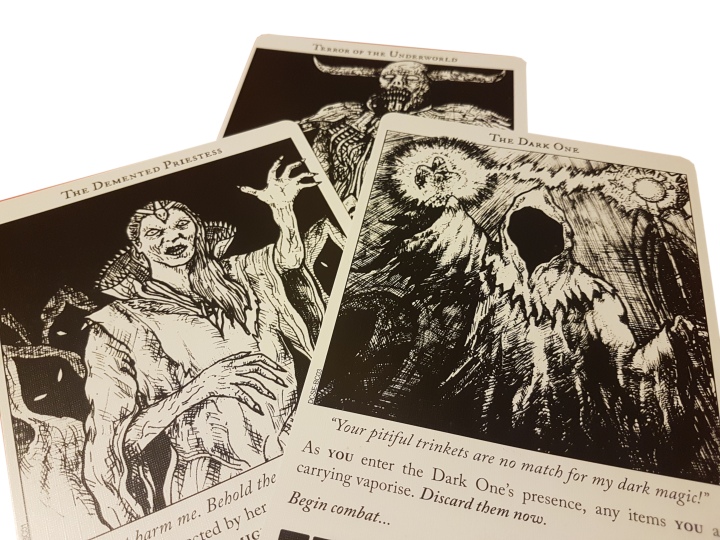
Escape the Dark Castle is an enjoyable, immersive quick adventure story/game that is easy to teach, quick to set up and easily accessible to many, including young children – just be prepared for some nightmares. This game will look different on your table, it will look different to the other games on your shelf. The beautifully bleak black and white art and graphics, the incredibly simple rules and brevity of the game create a fabulous mixture of short, intense storytelling, that, like any good game, or book will have you revisiting time and again.

This review is based on a full retail copy of the game provided by the publisher.







I’m potentially an ‘instabuy’ customer for this game as I love choose-your-own adventures (I received Warlock of Firetop Mountain as a Christmas present in the year it was first published). However, with each game only featuring 15 chapter cards, and only 45 in total in the game, I just can’t imagine that it captures the feeling of gamebooks which typically have 400 entries.
LikeLiked by 1 person
Well, you may be pleased to hear then that there is already an expansion and more planned. I’d say it is certainly worth a look at 🙂
LikeLike
Well, I’m still interested in it, but not sure I want to buy it without trying it. I’ll see if I can borrow a copy. I love Gloom of Kilforth as a solitaire game, which is what I would inevitably compare this type of game to, but that is a longer and more complex game.
LikeLike
My other concern is comments from people who have played it that it is a very simple game. It seems to be pitched as something closer to a filler than a full game. It was played at a boardgame club last week and went down like a lead balloon. I didn’t ask them why, but I assume the game play is too simple and luck-based for hardcore euro gamers.
LikeLike
I played the game and didn’t like it. In my opinion, it just doesn’t capture the spirit of Fighting Fantasy game books in any meaningful way (I’ve been replaying them recently and still find the better ones very enjoyable). Perhaps the art is similar to that of those 1980s game books, though I don’t find it nearly as good as the art featured in many of them (e.g. by Russ Nicolson or Iain McCaig).
LikeLike
Good on you for giving it a go though, sorry to hear you didn’t feel it had the bite you had hoped for
LikeLike